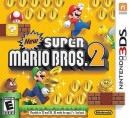Wow I totally agree with Squilliam. Never thought this would happen. Like all IBM products (for example the CELL), the PowerPC was very powerful when the developer knew what he was doing. In normal situations the advantage wasn't that big. Besides that the XBOX had a standard GPU with shader units that could be programmed with Direct3D and the Gamecube had a proprietary GPU with some weird programming models.
Which explains why XBOX games all in all looked better (Exceptions prove the rule)
And let's not even get started about this generation.
Existing User Log In
New User Registration
Register for a free account to gain full access to the VGChartz Network and join our thriving community.






















































